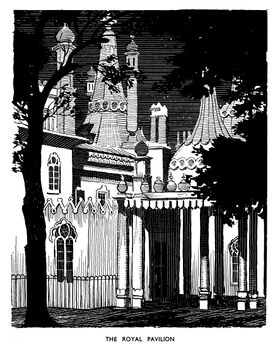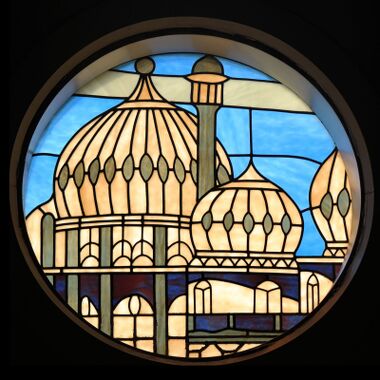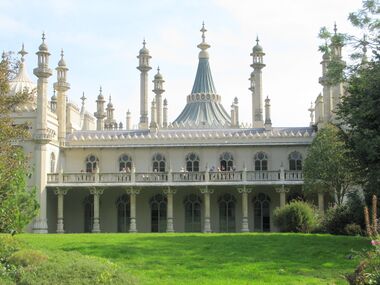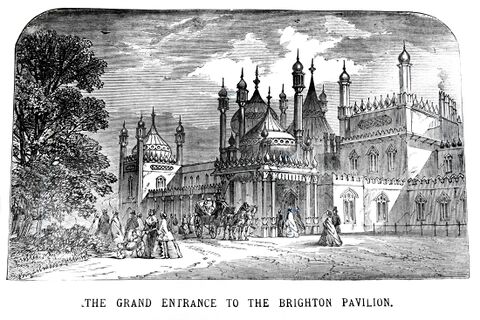Category:Brighton Royal Pavilion
1935: "The Royal Pavilion", lineart by Arthur Watts [image info]
Brighton Pavilion (stained glass window at Brighton's Palace Pier) [image info]
Brighton Pavilion, from the Pavilion Gardens, 2011 [image info]
Brighton Pavilion, gallery, 2011 [image info]
"Entrance to Royal Pavilion, colourised postcard showing the entrance some time before the construction of the India Gate in 1921 [image info]
Brighton's Royal Pavilion was originally a farmhouse building across the road from The Steine, but was extensively and repeatedly redeveloped and extended to become the current structure.
The Marine Pavilion
Carlton House's designer, Henry Holland, was hired to extend and enlarge the farmhouse into something more suitable, and the original building became one of two neoclassical wings flanking a central domed rotunda, known as the Marine Pavilion.
More land was purchased around the building and used to build an impressive and ornate set of stables, which is now the Brighton Dome complex (and now incorporates the Brighton Dome and Brighton Museum and Art Gallery).
The Royal Pavilion
Perhaps spurred by comments that his horses lived in a finer palace then he did, George then hired John Nash (the architect of the Houses of Parliament) to revamp the Pavilion to become something rather more palatial, the result being an almost obscenely opulent-looking building with onion domes and an Indian-style exterior, and Chinese and Indian-themed interiors, with as much decoration as could be crammed into the available space.
Sale to Brighton, 1850
George died in 1830, and when Queen Victoria came to the throne in 1837 she didn't seem to approve of the Pavilion, which had a relatively small number of large rooms, whereas Victoria's family and entourage required a larger number of perhaps smaller rooms. The Pavilion was also too near the main road and Brighton was now starting to attract large numbers of day-trippers from London via the new railway line terminating at Brighton Station (1841). Victoria sold the Pavilion to Brighton in 1850, and had the loose fittings removed and taken away -- many of which subsequently migrated back to the Pavilion over the following years.
Magnus Volk and electric lighting, 1883
- " ... it was soon after this that he became interested in electric lighting. This led to his appointment as electrical engineer to the Corporation of Brighton, and in 1883 he lighted the Royal Pavilion estate electrically. This installation was then the largest of its kind in the country. A large chandelier in the Dome of the Pavilion was wired for 200 lamps, which had carbon filaments, and the 200 gas fittings in it were retained for possible use in emergency. This made Mr. Volk’s work more difficult, for his insulating materials had to be capable of withstanding the heat of the gas flames. "
The Career of Magnus Volk (1851-1937), Meccano Magazine 1937
World War One
The Pavilion was then used as a military hospital for Indian soldiers during World War One, leading to the donation of the India Gate to the town in 1921 by grateful supporters back in India (including the Maharajah of Patiala).
1933 description:
External links
- Royal Pavilion, homepage (brighton-hove-rpml.org.uk)
- Brighton Pavilion (historicengland.org.uk)
- History of the Indian Gate, by Bert Williams (mybrightonandhove.org.uk)
- Unveiling of the Indian Gate — 26 October 1921 (rpmcollections.wordpress.com)
music:
Pages in category ‘Brighton Royal Pavilion’
The following 3 pages are in this category, out of 3 total.
Media in category ‘Brighton Royal Pavilion’
The following 16 files are in this category, out of 16 total.
- Brighton By Night, by HG Gawthorn (BrightonHbk 1935).jpg 2,200 × 1,502; 2.44 MB
- Brighton Map (VisitBrighton 2011).jpg 1,417 × 3,000; 4.04 MB
- Brighton Pavilion (stained glass at Brighton Palace Pier).jpg 1,600 × 1,600; 288 KB
- Brighton Pavilion 043, 2011.jpg 1,650 × 2,200; 1.29 MB
- Brighton Pavilion 048, 2011.jpg 2,200 × 1,650; 1.4 MB
- Brighton Pavilion Grand Entrance, engraving (NGB 1885).jpg 2,200 × 1,467; 878 KB
- Brighton Pavilion in 1788 (NGB 1885).jpg 2,200 × 1,462; 635 KB
- Brighton Pavilion, Ted Bayley, detail.jpg 1,600 × 1,200; 1,010 KB
- Brighton Science Festival, poster (BSF 2016).jpg 605 × 857; 146 KB
- Heritage Learning Brighton and Hove.jpg 142 × 120; 9 KB
- Old Steine (BHAD10ed 1933).jpg 3,000 × 1,893; 3.29 MB
- Pavilion Estate, 1939 map (BrightonHbk 1939).jpg 1,371 × 1,372; 929 KB
- Royal Pavilion, lineart, Arthur Watts (BrightonHbk 1935).jpg 1,776 × 2,200; 1.8 MB
- The Prince of Wales' Pavilion at Brighthelmstone, after Charles Middleton 1788.jpg 2,200 × 1,539; 509 KB
- The West Front of the Pavilion, from a drawing by Pugin 1888.jpg 2,200 × 1,480; 431 KB


























